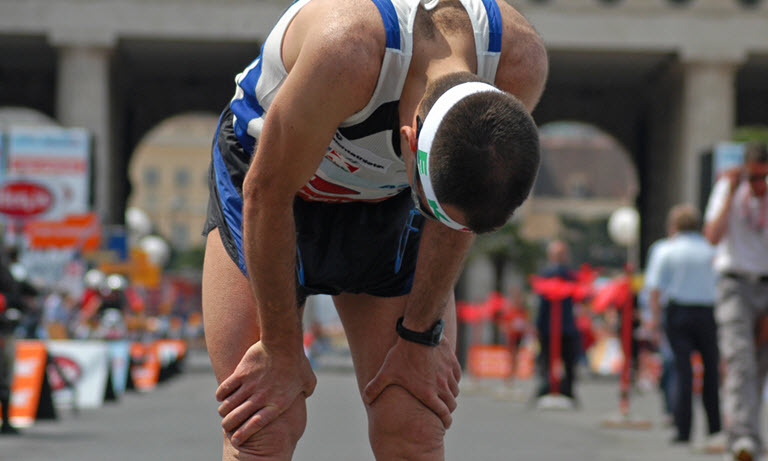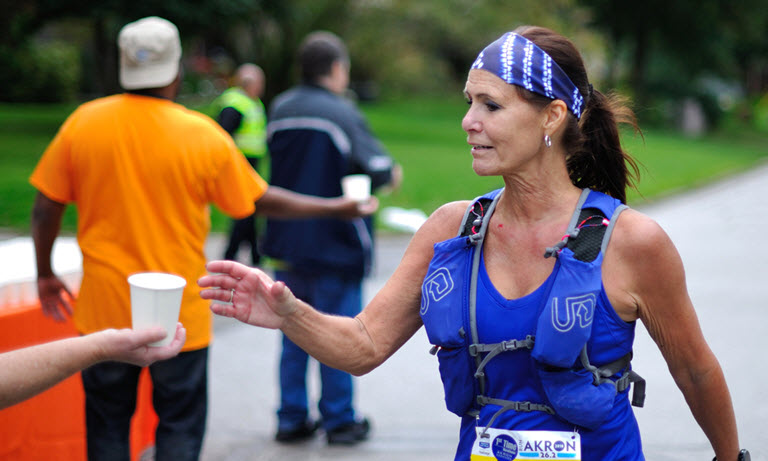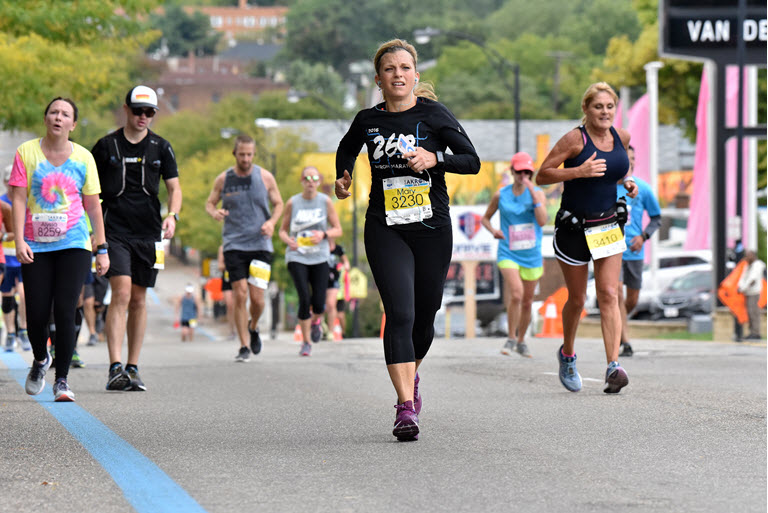
HOW TO BEAT THE WALL DURING YOUR MARATHON
You’re running your marathon at a good pace and you’re somewhere near mile 20 when that ominous feeling hits you. First comes the sudden fatigue, a loss of energy that makes every movement harder. Then your legs start to feel as heavy as the pavement you’re running on. It’s like you can’t take another step. You’ve hit the dreaded “wall”.
If this has happened to you, you’re not alone. Whether you’re a recreational runner or an elite athlete, anyone who runs long distances risks hitting the wall. Hitting the wall forces you to slow down your pace, sometimes to a walk or to the point you need to take a break.
The Wall – Not Just in Your Head
Many runners try to push through when they start hitting the wall because they think it’s something in their head, but that’s not necessarily the case – there has been extensive research by exercise physiologists that shows runners “hit the wall” because they run out of glycogen (carbohydrates) stores.
Understanding where “the wall” comes from is one thing but overcoming it can be more challenging. Here are some tips for how to prepare yourself before and during your race to avoid hitting the wall during a marathon.
Before Your Race
Train Your Body with Weekly Long Runs

As you train for your marathon, a solid base of running mileage and fitness will allow you to race longer and stronger. You should follow a training program and should be running on a regular basis, and gradually build your training over a period of time while including a weekly run that gets progressively longer as your race date nears. By progressively lengthening your runs, your body’s capacity to store more glycogen within its muscles increases. Increased glycogen stores mean that you’ll train your body to maintain your pace and push off fatigue. Longer, slower training runs also help to teach your body to tap into energy reserves from fat storage sites. There have also been a few recent studies done that show increased endurance in marathon runners who train on low glycogen levels.
Training Tips: Your marathon training program should include weekly long runs building up to 18-22. You can also test out pre-breakfast runs to understand how your body responds. When you wake up in the morning, your glycogen stores are low so running in a fasted state will make your body turn to fat for fuel. If you don’t want to run on an empty stomach, eating a small amount of fat like peanut butter before you run will also help kick-start your fat burning metabolism. You should also make sure to train on similar terrain to the race course. Your body will adapt to the impact so you have less of a risk of muscular issues on race day.
Set Your Pace and Stick to It

If you have a goal marathon time, you should be sure to include race pace runs into your training plan.
Not all training runs should be at goal race pace, but race pace runs are important as part of your training plan to prepare your body for race day. They can be incorporated as one of your weekday runs and/or last few miles of your long run.
Don’t know what your marathon pace is? A quick formula that some runners use is to take a recent half marathon time, double it, and then add 10 to 20 minutes depending on the difficulty of the course.
Training Tips: While training, save enough energy to run your race day pace for the end of your long run when you are already slightly fatigued because it will help your body become more familiar with running at your goal marathon pace and will help you avoid “the wall” as you approach race day. If you’d like to dive deeper into calculators and race time prediction, check out this article from Verywell fit.
Get Your Body Ready to Race

Three to five days before your race, you should be done with training and should be getting your body ready for race day. At the same time, you should be fueling your body to ensure your energy stores are topped off for the day. As far back as the 1930s, researchers put athletes on high-carbohydrate diets and compared them with people eating mostly protein. The carb-eaters had more endurance than the protein eaters.
Training Tips: The week after your long run, you should start tapering your mileage to allow your muscles to rest. Two to three days before your race you should start carbo-loading with carbohydrates. Eating a high-carb diet, together with a reduction in the volume and intensity of your training helps ensure your glycogen stores are fully stocked up so you can push through your race and avoid hitting the wall.
During the Race
Keep Your Pace

On race day, you’ll be excited, the adrenaline will be pumping, and you’ll feel great. This might be the case, but don’t let it fool you into going out too fast and running ahead of pace. At faster speeds, your body relies more heavily on glycogen as a source of fuel and less on fat so if you run too fast early in the race, you run the risk of depleting your glycogen stores sooner.
Training Tips: To avoid hitting the wall, you want to pace yourself in the easy effort zone early, progress to a moderate effort, and the hit it hard for the finish. Tune into your body and breathing so you know when your body is running in the easy, aerobic zone and when you cross into the hard zone when you’re burning more glycogen. It may feel counterintuitive but go ahead and take those walk breaks during your marathon. When you take short, strategic walk breaks, you’ll end up feeling better during your last home stretch than if you ran the entire distance.
Fuel On-the-Run

Set up a plan for when you plan to fuel throughout the marathon. Make sure to fuel early – before you feel you need it – to avoid hitting the wall. In addition to glycogen depletion, dehydration creates a risk of fatigue as well for runners. No matter the weather, you should be drinking “a little, but often” throughout the race.
Training Tips: A common guideline from sports nutritionists is to consume 30 – 60 grams of carbohydrates per hour and approximately 3.3 – 5 fl. oz of fluid every 5km. Energy gels are a great carb source during a run because they’re portable and easily digestible. Also, while most nutritionists will tell you to stay away from sports drinks on a regular basis, in this case, it’s actually helpful – they are hydrating and have the added benefit of containing sugar to help supplement your glycogen stores.
Trick Your Brain

“The wall” can be just as much mental as it is physical. While running, you should try to find ways to stay mentally engaged with the task at hand on race day.
Training Tips: One way to stay mentally engaged is think of the marathon as three shorter races – 10 miles – 10 miles – 10K. When you tackle each one separately, it might give you some additional motivation. You can even have a reward – whether it’s a gel, a special treat, or a group of cheering friends – waiting for you at the end of each of these “mini-races”.
If You Still Hit the Wall

Running a marathon isn’t easy. You can do all the exact right things before and during the race and you might still hit the wall. Weather conditions, how you’re feeling that day, even the crowd around you can have an effect on how you run. Don’t be discouraged, take notes of all the details of your race and keep them in mind for the next one you sign up for – cause who are we kidding – no matter the results, of course there will be a next one!
When you participate in the FirstEnergy Akron Marathon, we make sure to give you all the tools you need to avoid hitting the wall. Regular fluid and energy gel stations throughout the course help you stay fueled for your race, a great community to cheer you on, and we have the extra advantage of our amazing new course that is downhill or flat for the final 6.2 miles – perfect for helping you keep your pace throughout the race.
The FirstEnergy Akron Marathon features the ultimate running experience through 13 Akron neighborhoods and a world-class finish inside Canal Park Stadium. Join us to enjoy a great course and a great community that runners have come to know and love.
FirstEnergy Akron Marathon, Half Marathon & Team Relay
September, 28, 2019 | 7:30am
Downtown Akron


